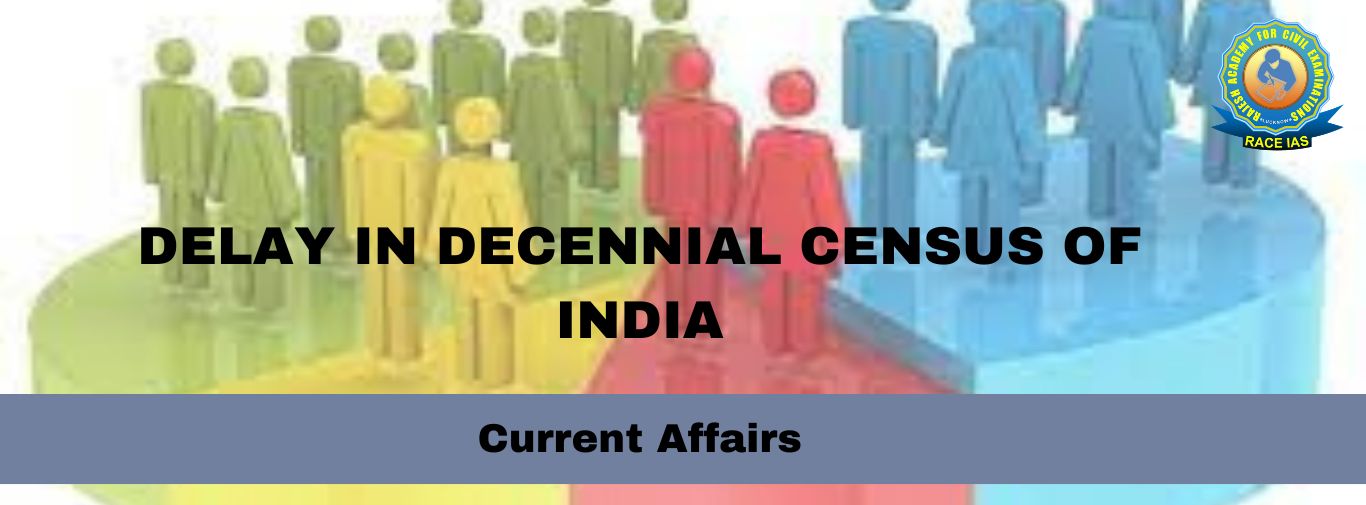
DELAY IN DECENNIAL CENSUS OF INDIA
DELAY IN DECENNIAL CENSUS OF INDIA
Reference:
- The decennial census to 2021 has been pushed again and is not likely to begin until at least September 2023. What are the reasons for repeatedly postponing the 2021 Census? What are the two phases of census? How will the delay in census affect administrative work, welfare schemes and other datasets? Is census important for understanding 'migration data' and 'migration patterns'?
How is the Census done:
- The first census of India was conducted by the colonial administration in 1881 and since then every 10 years.
- Census starts on the same day or in a year in the regions of the country. The decennial census is conducted in two phases by lakhs of enumerators enlisted and trained by the government.
- The first stage is the housing census, where data is collected on housing conditions, household amenities and assets held by households.
- The second phase is where data is collected on population, education, religion, economic activity, scheduled castes and tribes, language, literacy, migration and fertility.
How many times the 2021 census delayed:
- Census in India is conducted under the Census Act, 1948. This act predates the formation of the constitution.
- The Act does not oblige the government to conduct the census on a particular date or release its data within a notified period.
- On March 28, 2019, the Central Government issued a notification in the Gazette of India to conduct the census for the year 2021. This census was to be effective from January 1, 2020 to March 31, 2021.
- But the census was put on hold due to the COVID-19 pandemic and the administration's overcrowding.
- In the year 2020 the census was postponed indefinitely.
- The date for conducting the census was earlier extended till December 31, 2020. It was again extended till December 31, 2021, then till June 30. Further extended again till December 31, 2022.
- On December 14, 2022, the Central Government informed that due to the outbreak of the COVID-19 pandemic, there has been a delay in the activities of Census 2021 and related fields.
- According to the UN data, many countries had stopped their census work due to the pandemic, but many of them, such as the US, UK, China and Bangladesh, have completed the census work so far.
The implications of the Delay in the Census:
- Census data is important for various administrative works, welfare schemes and other surveys.
- The Finance Commission allocates funds to the states on the basis of census data.
- Censuses are important for determining the population of migrants and patterns of migration.
- According to the National Statistical Commission, census data is important for other sample surveys conducted in the country. This served as the framework for the sample survey.
- The Constitution of India mandates the use of census data for delimitation of constituencies, to determine the ratio of reservation for Scheduled Castes and Scheduled Tribes.
- Census data is essential for important changes in demographics and government data from health to educational enrollment.
- In addition, the census is important for determining the population of migrants and the pattern of migration.
Proposed Digital Census:
- The upcoming census in India will be the first to be conducted through both digital mode and paper schedule (questionnaire/form).
- In 2022, the central government will amend the Census Rules made in 1990 to enable the details to be captured and stored electronically and to enable self-enumeration by respondents.
- Ministry of Home Affairs informed the Parliament in December, 2022 that mobile and web applications for data collection and a portal for management and monitoring of various census related activities (CMMS) have been developed so far at a cost of Rs 24.84 crore.
Conclusion:
- The social, economic and political development of any country depends to a great extent on the population and available resources of that country.
- New census data is used by the government to administer the Public Distribution System (PDS) to distribute subsidized food grains.
- According to the National Food Security Act, 2013, 75% of the rural population and 50% of the urban population – a total of 67% of the country's population – are entitled to receive subsidized foodgrains from the government under the Targeted Public Distribution System (PDS).
- According to economist Jean Dreze, as of the 2011 census, India's population was approximately 121 crore, and PDS beneficiaries were approximately 80 crore.
- At the same time, due to the increase in population in the last decade, the PDS coverage should have increased to about 92 crores in the estimated population of 137 crores in the year 2020.
- As of June last year, the number of districts in the country has increased from 640 in 2011 to 736 at present, the number of sub-districts has increased from 5,925 to 6,754, and the number of villages has decreased from 6,40,934 in 2011 to 6,39,083 in 2021.
- With the introduction of digital census by the Government of India, the desired people will get the benefit of welfare schemes, as well as real and reliable data of the census will also be received.
- As the census work is politically sensitive and necessary for social, economic and political justice, the census related activities should be completed every 10 years.